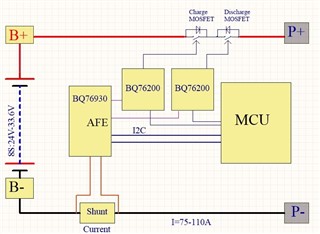The customer uses BQ76200 to drive the battery charge and discharge, with the maximum continuous current of 110A.
The customer charges in parallel with 11 MOS tubes for discharging, and 11 MOS tubes are used for discharging.The specifications of the MOS tube are as follows.The customer is concerned that the time of shutting off the MOS tube for a single BQ76200 is not fast enough during the over-current protection, and the shutdown time should be less than 50us during the over-current protection.The customer's thinking was that the drive capability of a single BQ76200 might not be able to reach that high speed.Therefore, the customer uses two BQ76200 to drive the charging and discharging MOS tubes respectively.
Now I would like to ask you a few questions:
1. Whether a single BQ76200 can meet the requirement that the tur-off time is less than 50us in the case of over-current protection;
2. If a single BQ76200 cannot meet the requirements of overcurrent protection and the tur-off time is less than 50us, can two BQ76200 be used to drive the realization?How to achieve this?Or is there a better solution?




